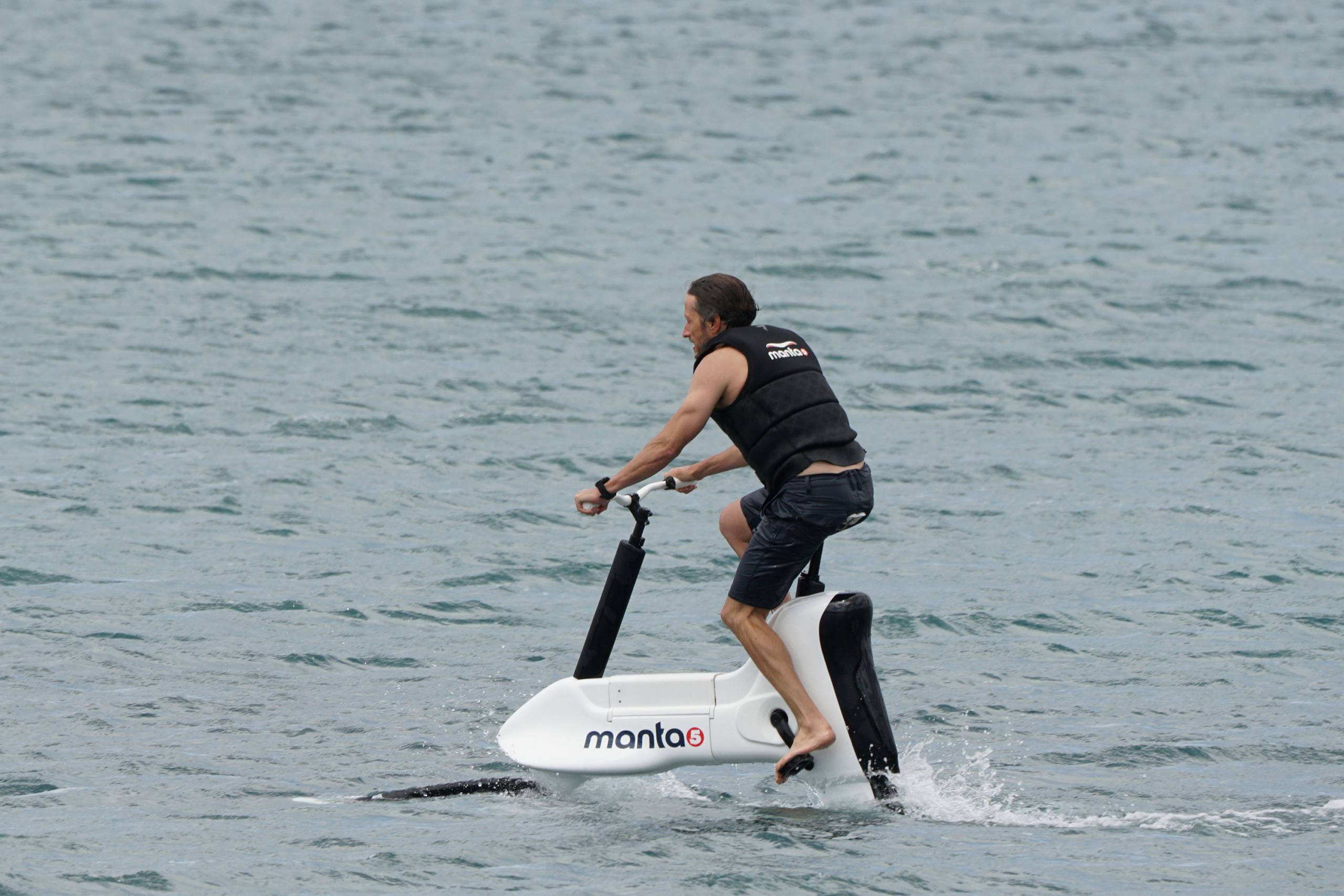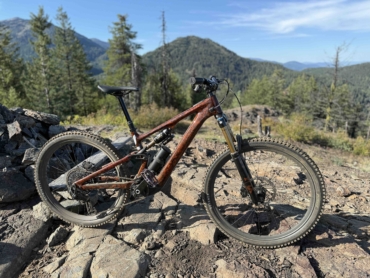Love to bike? Pedal on rivers, lakes, or oceans with the Manta5 Hydrofoiler XE-1 e-bike.
Guy Howard-Willis founded Manta5 in 2011, bringing to life one of his recurring dreams — cycling on water. He teamed up with designer Roland Alonzo, and they tweaked and trialed their way to a prototype.
Since those early days, the company — based on the North Island of New Zealand — has grown to 30 employees. The first consumer-ready model, the XE-1, reached New Zealand consumers in January 2020 and international markets last summer.
Manta5’s Hydrofoiler XE-1 seems to defy simple categorization. During operation, it looks and feels a lot like riding a bicycle. But it doesn’t have any wheels, so it technically isn’t one. It’s also used on the 70% of the planet where there simply aren’t any trails: rivers, lakes, and oceans.
I had the opportunity to catch up with the Manta5 team for an in-depth look at (and trial of) this hydrofoil e-bike. Read on for the full review, and take a look at our editor’s video rundown below for an overview.
Manta5 Hydrofoiler XE-1 Review
Setup
I headed straight to the beach after Manta5’s marketing director, Louis Wilks, picked me up at the Auckland Airport, an hour’s drive from the company’s headquarters in Hamilton. In the back of the van sat two gleaming white machines and several black carbon fiber blades.
Each “bike” disassembles to allow for easy transport, either via a roof rack or in the back of a hatchback or similar with the seats folded down. Once at the beach, I eschewed Wilks’ offer for help carrying the bike down to the sand. I wanted to get the full experience that I might have were I to be there on my own.
I took two trips to take the Hydrofoiler parts the short distance to the beach. First, I carried the bike on my shoulder and the longer rear foil in one hand. Next, I carried the front foil assembly and the small but heavier battery module. Neither trip was particularly difficult, but certainly, easy beach access is advantageous.
Once on the beach, assembly proved simple. Each foil attached to the upturned bike with a couple of bolts (tightened with the included Manta5-branded Allen key tool). And the sealed battery pack simply clicked into its home on the underside of the bike’s frame. The whole process took a couple of minutes and was very straightforward.

Durability
The demo bike I rode was well-used, making the rounds at media appearances and trade shows around the world for a couple of years. Nonetheless, it looked nearly new.
I initially thought the whole contraption must be pretty fragile. But I abandoned that idea when Rory, the team rider who taught me the basics, simply lifted the front of the bike and dragged it into the water. “You don’t want to beat on them,” he said, “but they’re plenty robust.”
The foils are made of strengthened carbon fiber set with high-performance epoxies, the body from aircraft-grade aluminum, and the internal buoyancy modules from vacuum-sealed ASA plastics. Tough stuff.
7 Battery-Assist Modes
The current model has seven battery-assist modes or speeds. At speed 7, simply turning the cranks activates the motor at full power and provides over 450 W of assistance. That’s enough to get the bike up and foiling (which takes about 350 W, give or take, based on the rider weight). At speed 1, the motor essentially shuts off, and you’re on your own.
This variability in assistance provides a phenomenal potential for using the XE-1 as a pretty awesome training tool. For example, riding at level 4 requires around 160 W of rider input to stay afloat in optimal conditions, in which case the battery lasts for around 3 hours. That’s a hell of a workout!

Launching: 3 Ways to Start
There are three ways to “launch” the Hydrofoiler on your own and begin foiling. The easiest of these is a platform launch off a floating dock, pontoon, or the back swim platform of a boat. A shallow-water start is slightly harder, with the bike half-submerged but resting on the bottom. Finally, and most challenging, is the deep-water start.
I managed a shallow-water start on my first attempt, but I learned it takes most people five to six tries. Buoyed by this experience and full of unearned confidence, I half expected them to offer to sign me as a team rider on the spot. So I asked Rory if I could jump right to a deep-water start.
This time, it took about 35 minutes to get a successful start. (It was a good thing they hadn’t offered me that contract.) Although the bike floats, it does so on its side. So launching from deep water requires essentially forcing the bike underneath you, turning it so that you can mount it, balancing perfectly, and then executing a well-timed initiation of pedaling and maintaining control while you rise out of the water.
It wasn’t easy, but through trial and error and lots of helpful suggestions from Rory, I was finally able to do it, just as I began to shiver from my long immersion.

How to Ride the Manta5 Hydrofoiler XE-1
The actual foiling was pretty amazing. It reminded me a lot of riding a road bike on the type of buttery asphalt that you long for as a road cyclist. Even in chop or swell, because the foils actually support you and remain under the water’s surface, it’s an altogether smooth experience. Turning was intuitive and required just a bit of a lean in conjunction with a slight turn of the handlebars, which have stops that prevent oversteering.
Coming out of the turn was a bit more awkward at first. Until I got the hang of it, I sometimes felt locked into the turning arc I created and had to throw my weight around to get out of it. But I improved each time, and 30 minutes into riding, I could pretty much get the bike to go exactly where I wanted it to go.
My riding experience took place in a pretty protected bay, although the wind came up toward the end of my riding and gave me a chance to see how well the bike performs in less-than-glassy circumstances.
Afterward, I asked Rory about the limits of the bike in terms of weather conditions. He reckons the rider’s limitations are more important. Manta5’s in-house team has ridden the bikes up and down rivers, out through the breakers at Raglan (a legendary surf beach), and surfed waves.
One team rider even rode across the Cook Strait — a nearly 30km journey through what are considered some of the most dangerous and unpredictable waters in the world — on a single battery charge.

Consider Cycling Shoes
I trialed the bike in board shorts and no shoes, but serious riders keen to push the wattage would want proper cycling shoes. Mashing hard on the included pedals is pretty tough on water-softened feet! Better yet, because the cranks accept standard cycling pedals, you can add clipless ones if you prefer.
Recreational cyclists living near coastal or inland waters should also take notice — even at full power (which should be in easy reach for almost any fitness level), the bike will run for more than 90 minutes on a single charge. With a cruising speed of around 10 mph, this gives a 15-plus-mile range and offers tremendous opportunities for waterborne exploration.
Manta5 Hydrofoiler XE-1: Price
Manta5 sent the first batch of 300-odd XE-1s to customers last year, with most of them going to the super-yacht crowd. (Richard Branson bought two.) Buyers have already claimed most of the next batch of over 900 bikes, but the hydrofoils have started to reach into other sectors. With the help of key distributors, according to rumor, Manta5 is making lofty plans of developing a new sporting discipline.
The Hydrofoiler XE-1 is currently available only by direct order from New Zealand for the tidy sum of $8,990. Some might consider this outlandish. But it’s not too far out of the realm of what a new high-end, full-suspension enduro bike costs these days. And it’s probably cheaper than what you’d pay for a top-spec e-bike for either the road or the mountains. When you consider the amount of new rideable terrain it will open up, it almost starts to sound like a bargain.
However, keep in mind that the listed price doesn’t include taxes or shipping, which the company website estimates to be between $380 and $1,000 per bike. The next production run is slated for May 2021, with bikes shipping at the end of that month.
Currently, Manta5 has taken orders for 50% of this next batch. So if you’re keen to be seen riding on the water this summer, it might be time to crack open the piggy bank or downsize your bike quiver.
Check Price at Manta5






